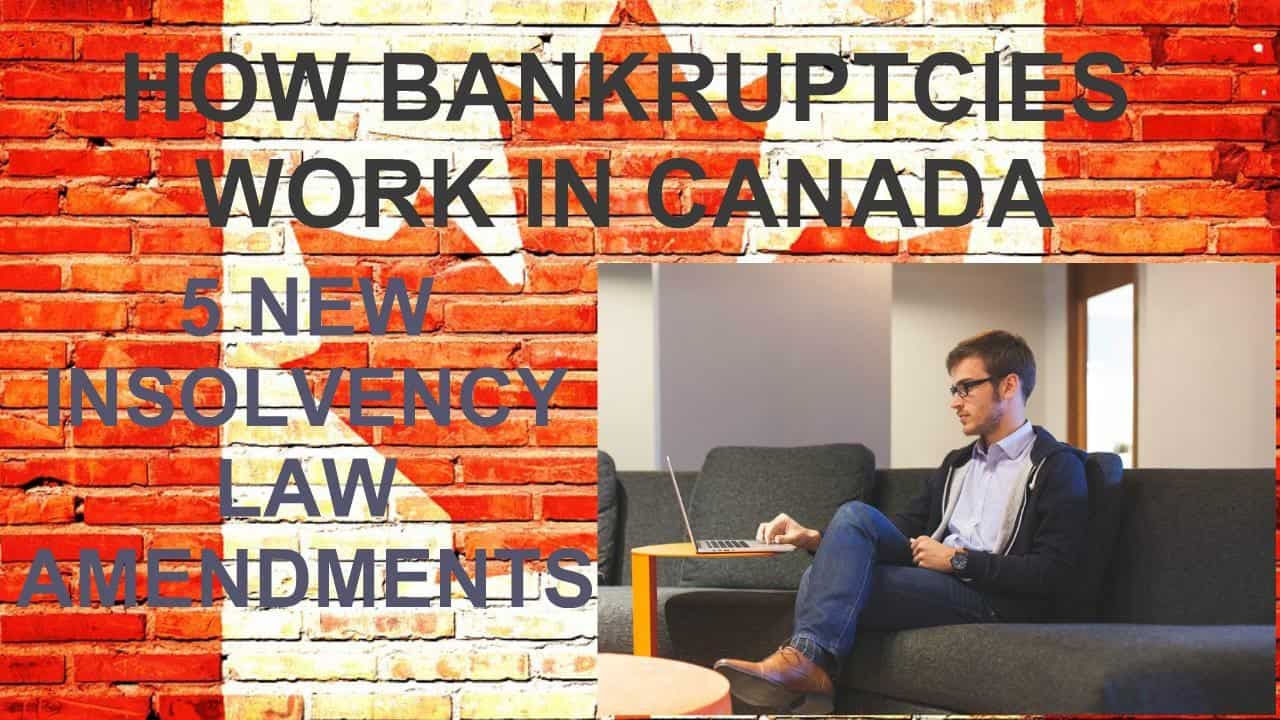If you would prefer to listen to the audio version of this how bankruptcies work in Canada Brandon’s Blog, please scroll down to the bottom of the page and click on the podcast
Canadian bankruptcies laws
Last week I wrote about amendments to Canadian insolvency law for intellectual property rights in my Brandon’s Blog INSOLVENCY LAW CANADA AMENDMENTS FOR INTELLECTUAL PROPERTY RIGHTS In addition to the intellectual property rights amendments, other amendments affecting how bankruptcies work in Canada. They were enacted as of November 1, 2019. They too were part of the changes announced in the Canadian 2019 Budget.
Corporate bankruptcies Canada
Most of the amendments affect not just corporate bankruptcies. Receiverships and corporate financial restructuring are likewise affected. Even the operation of solvent companies is also affected. The amendments were made to the Bankruptcy and Insolvency Act (R.S.C., 1985, c. B-3) (BIA), Companies’ Creditors Arrangement Act (R.S.C., 1985, c. C-36) (CCAA) and the Canada Business Corporations Act (R.S.C., 1985, c. C-44). I will focus on the changes to the BIA and CCAA.
The BIA and the CCAA modifications in the Budget Implementation Act, 2019, No. 1, are planned to boost retired life protection by making the insolvency treatment fairer and much more clear. In the legislation, the amendments fall under the heading “Enhancing Retirement Security”.
This issue remained in the news over the past two years. High profile insolvency situations such as Sears Canada and U.S. Steel Canada brought this matter to the forefront. I wrote a few blogs on the topic of proposals to change the BIA and CCAA. The proposals were meant to supply protection to senior citizens. This consisted of private members’ bills introduced by Hamilton Mountain NDP MP Scott Duvall, Bloc Québécois MP Marilène Gill and Senator Art Eggleton, P. C.
None of their Bills ever came close to being enacted. Rather, the Liberal government made some changes. Only time will tell if the changes I describe below will accomplish the stated goal of enhancing retirement security.
Insolvency and bankruptcy code amendments – BIA
The BIA amendments will apply to bankruptcy, receivership and BIA financial restructurings done under the Proposal section of the BIA. The amendments are aimed at several areas. All the insolvency amendments are for insolvency proceedings beginning on or after November 1, 2019.
1. Good faith
Section 4.2 of the BIA is amended by adding a good faith provision section(4.2)(1). The new language states that any interested person in any type of process under the BIA must act in good faith relative to those proceedings. New subsection 4.2(2) codifies a power for the Court. It now states that if the court is satisfied that an interested individual fails to act in good faith, on application by any other interested party, the Court might make any kind of order that it thinks is proper in the circumstances.
I would have hoped that acting in good faith was always a given. Previously, the Court had wide discretion in insolvency proceedings to make an order that it believed to be just and appropriate. I am not sure this new language adds much to “enhancing retirement security”, but at least now it is codified.
2. Registered disability savings plan
Before Budget Canada 2019, there was a gap when it came to a registered disability savings plan (RDSP). The gap was that unlike an RRSP or RRIF, there was no exemption for an RDSP in how bankruptcies work in Canada.
Now Paragraph 67(1)(b.3) of the BIA is amended to include the same exemption for an RDSP that an RRSP and RRIF enjoy. That is, the amounts in any of these funds are now exempt from seizure in a bankruptcy apart from property added to any such plan or fund in the twelve-month period before the date of bankruptcy.
3. Director liability – Inquiry into dividends, redemption of shares or compensation
Section 101(1) of the BIA has been amended. It now deals with certain transactions that 1 year before the corporation went bankrupt. The time period is within the day that is one year prior to the date of the initial bankruptcy event and ending on the date of the bankruptcy both such dates included. If the corporation had:
- paid a dividend, aside from a stock dividend;
- redeemed or acquired for cancellation any one of its shares of the company’s capital stock; or
- has paid termination pay, severance pay or incentive or other benefits to a director, officer or any person that manages or controls the business
the Court may, on the application of the licensed insolvency trustee (Trustee), inquire into the transaction to find out whether it took place at a time when the firm was insolvent or whether it made the firm bankrupt.
If a transaction referred to above has actually occurred, the Court can give judgment to the Trustee against the directors of the firm, jointly as well as severally, or individually as appropriate in the circumstances.
The amount of the pay or benefits, with interest on the amount, that has not been paid back to the company if the Court discovers that the payment of the pay or benefit:
- occurred at a time when the company was insolvent or it made the corporation bankrupt;
- was notably over the reasonable market price of the consideration gotten by the company;
- was made outside the common course of business
and the directors did not have reasonable grounds to think that the payment:
- took place when the firm was not insolvent or would not render the firm insolvent;
- was not conspicuously over the fair market value of the consider obtained by the corporation; and
- was made in the ordinary course of business.
Interestingly, the new statute also states that a judgment will not be made against or be binding on a director who had protested against the payment of the pay or benefits and had, therefore, vindicated himself or herself under the relevant corporate legislation from any kind of resulting obligation.
No doubt we will only learn how effective this additional liability of directors provision will be after several court cases. Presumably, this amendment to the statute will provide extra food for thought for the insurance companies providing director and officer liability coverage.
Insolvency proceedings under the CCAA
The CCAA covers larger company financial restructuring. In addition to amendments to the CCAA to mirror the BIA amendments discussed above, there were also a couple of other changes made.
4. Initial application
Prior to November 1 CCAA filings, the company was given an initial stay of proceedings for 30 days. Now, for filings November 1, 2019, and after, this initial stay period has been reduced to 10 days.
5. Relief reasonably necessary
An initial order made or during the 10-day initial application stay period will be limited to alleviation that is fairly required for the continued operations of the borrower business in the regular course, but no extra relief will be granted. This narrowing of relief during the initial order period means that the Company cannot ask for all sorts of extra relief outside of the normal course of business.
In order to attempt to get extra relief, the Company will have to make a motion to the Court on notice to any affected parties. The Company will not be able to pack it into an initial order and force affected parties who did not receive notice to have to come to Court under the comeback clause. This was the case before November 1, 2019.
Most times in a CCAA restructuring, it is necessary for the Company’s survival to get debtor-in-possession financing. When such financing is available, it usually comes with very onerous terms. To avoid essentially keeping all of the Company’s assets out of reach by using such financing, the CCAA has been amended. It says that when applying for the initial order or during the initial stay period, no order shall be made unless the court is pleased that the terms of the loan are restricted to what is reasonably necessary for the continued operations of the debtor firm in the ordinary course of business during that initial stay period duration.
In this way, Parliament has tried to put the brakes on wide-sweeping initial orders that have everything including the kitchen sink in them. Parliament wants to have the initial orders contain only what is reasonably necessary to keep the Company’s operations going until everyone is back in Court all lawyered up.
It will be very interesting to see what Court decisions come from all of these new amendments to the Canadian insolvency laws.
Summary
I hope you enjoyed this how bankruptcies work in Canada Brandon’s Blog on the other BIA and CCAA insolvency amendments effective November 1, 2019. Are you or your company in need of financial restructuring? The financial restructuring process is complex. The Ira Smith Team understands how to do a complex corporate restructuring. However, more importantly, we understand the needs of the entrepreneur. You are worried because your company is facing significant financial challenges. Your business provides income not only for your family. Many other families rely on you and your company for their well-being.
The stress placed upon you due to your company’s financial challenges is enormous. We understand your pain points. We look at your entire situation and devise a strategy that is as unique as you and your company’s problems; financial and emotional. The way we deal with this problem and devise a corporate restructuring plan, we know that we can help you and your company too.
We know that companies facing financial problems need a realistic lifeline. There is no “one solution fits all” approach with the Ira Smith Team. That is why we can develop a company restructuring process as unique as the financial problems and pain it is facing. If any of this sounds familiar to you and you are serious in finding a solution, contact the Ira Smith Trustee & Receiver Inc. team today.
Call us now for a free consultation. We will get your company back on the road to healthy stress-free operations and recover from the pain points in your life, Starting Over, Starting Now.
[monkeytools msnip=”https://monkeyplayr.com/playr.php?u=5173&p=21696″]


